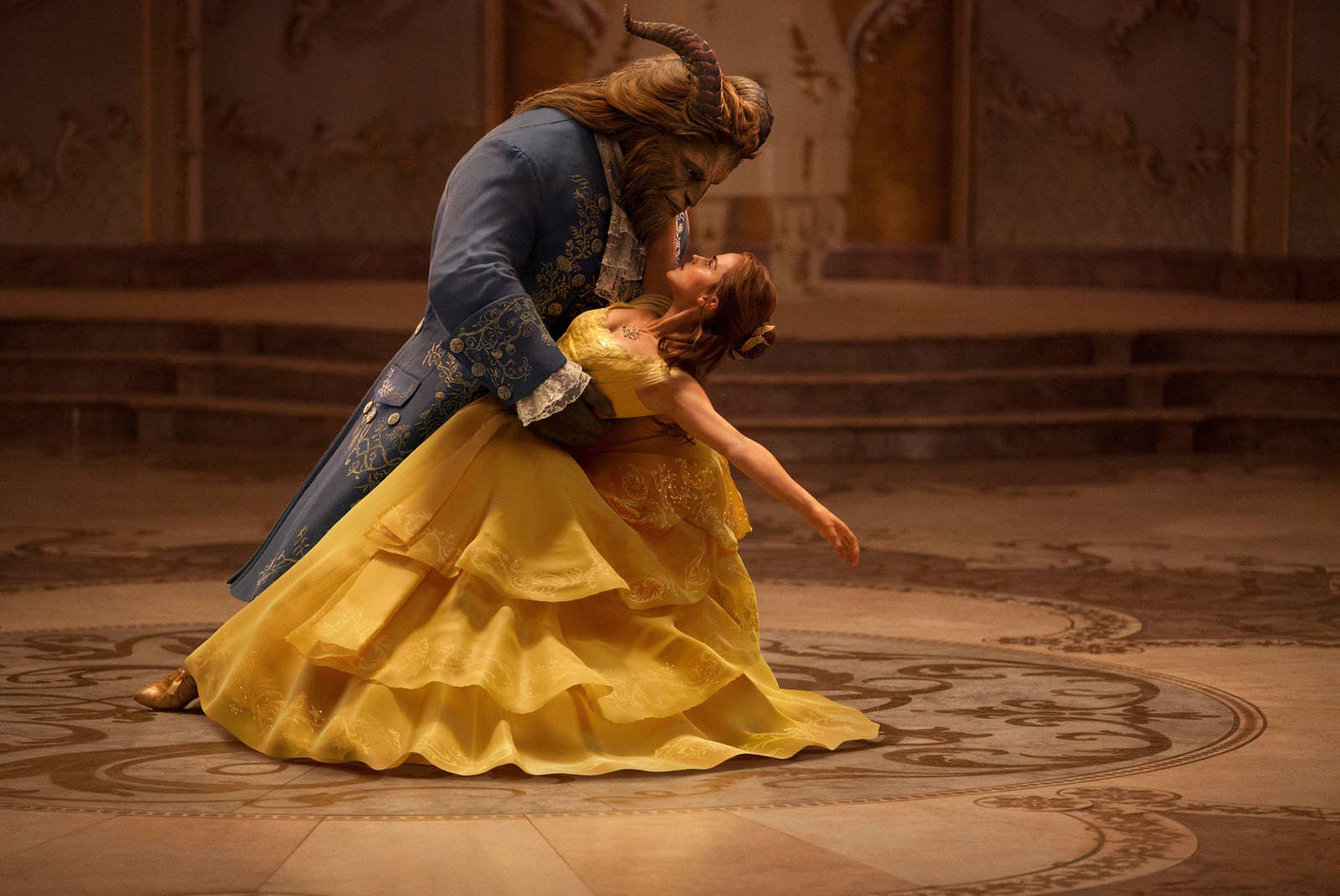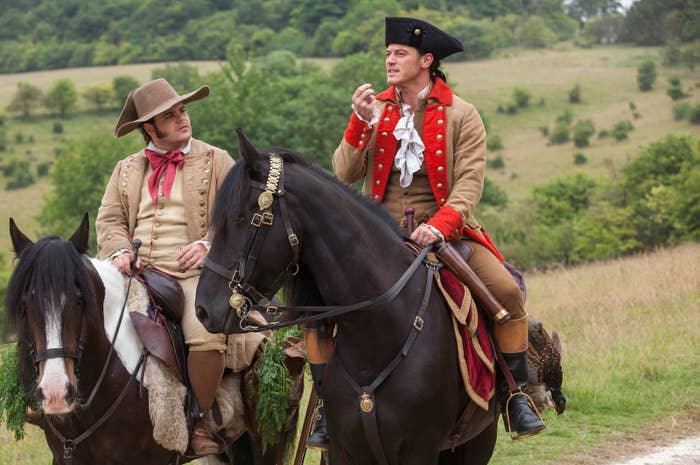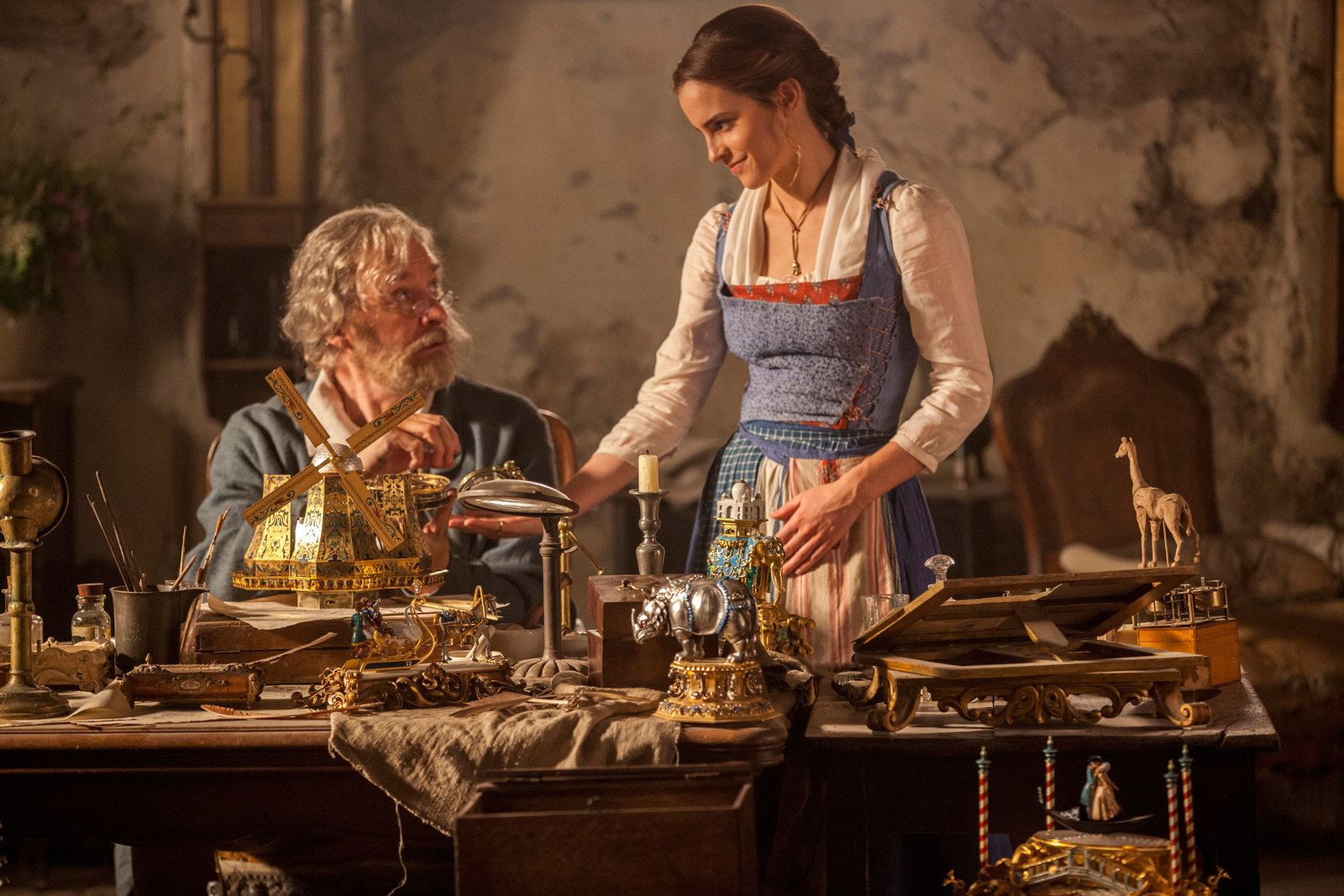
“Remake” isn’t a strong enough word to describe the relationship between Disney’s new live-action Beauty and the Beast and the company’s beloved 1991 animated movie. It doesn’t do justice to just how beholden the new film, directed by Dreamgirls’ Bill Condon and starring Emma Watson as Belle and Dan Stevens as the Beast, is to the older one. “Re-enactment” might be more accurate.
It's to be expected that 2017’s Beauty and the Beast revisits all the well-known songs (while slipping in a few not-so-memorable new ones) and the characters from the first film. But it also recycles the looks, the settings, much of the dialogue, and, eerily, many of the visual beats. It is less an experience in itself as it is an exercise in evoking memory of a whole other movie. There are sequences in which it comes across like the most extravagant viral video ever made — “Here’s a Side-By-Side Comparison of the Old “Beauty and the Beast” Vs. The New One (Spoiler: It's Perfect)."

It’s a masterstroke of corporate calculation (you loved this once, so why not buy it again?), a loaded syringe full of sticky-sweet nostalgia, and everything about it is profoundly depressing.
Beauty and the Beast is the most recent in a rapidly expanding series of live-action remakes of Walt Disney Animation Studios films, the Mouse House leveraging its existing intellectual property with the zealousness of a brand going all in on the idea that the future is in the past.
This venture started off with films that provided revisionist takes on their source material, with the assumption that 19th-century novels and fairy tales could use a refresh. Tim Burton turned Alice in Wonderland into an eye-popping if soulless action-adventure-empowerment flick in 2010, while Angelina Jolie transformed Sleeping Beauty’s vampy villain into a misunderstood and mistreated antihero in 2014’s Maleficent.
They were hits, but then so was the next year’s Cinderella, which was instead a startlingly straightforward take on the whole stepmother-ball-shoe-prince affair. It wasn’t a musical, but otherwise borrowed freely from its animated predecessor with a “why mess with a good thing” blitheness, no matter how wan its title character felt when rendered in the flesh without any significant update. Continuing the slide toward recreation was last year’s The Jungle Book, a halfway musical that plucked a few choice songs from the older version, its advances entirely technological, bound up in the dazzle of its photorealistic effects.

And now we have Beauty and the Beast, an inevitable end point of this progression — a movie that basically just reskins the one that inspired it. It’s an autotuned cover version of the original that impresses only in how lavishly it corporealizes what were once just drawings. Condon’s film, which was written by Stephen Chbosky and Evan Spiliotopoulos, does provide some extra backstory for both main characters that adds nothing but minutes to the runtime.
More notably, it offers some tiny tweaks on the old script that have managed to get a ridiculously outsized amount of credit. There is what Condon described as an “exclusively gay” moment involving LeFou (Josh Gad), the forever fawning sidekick to hunky antagonist Gaston (Luke Evans), leading to a flurry of media coverage about Disney unveiling its first canonically gay character. But what’s actually in the film is so blink-and-you’ll-miss-it and inconclusive that Condon himself tried to walk the fuss back as “overblown.”
Then there was the claim, also from Condon, that the smooches between Madame de Garderobe (Audra McDonald) and Cadenza (Stanley Tucci), and then Plumette (Gugu Mbatha-Raw) and Lumière (Ewan McGregor), constituted the “the first and second interracial kiss in a Disney movie” — which was not actually true. There’s also the fact that the presence of McDonald, Mbatha-Raw, Ray Fearon, and scattered background players make for a more diverse cast, but predominantly in roles that involve appearing as talking furniture or feather dusters for most of the runtime.

And above all, there’s the drumbeat that this version of Beauty and the Beast is more feminist, pinned to an incidental sequence in which Watson’s Belle comes up with a proto-washing machine, only for the community to react badly to the sight of her using it. (Since it takes up the whole of the town’s shared fountain, it’s possible they just found this to be a dick move on her part.)
What could actually be feminist is some genuine reckoning with a narrative that still involves a woman falling in love with the hot-tempered man-monster who imprisons her, which stands out more starkly without the innate abstraction provided by animation. Or acknowledging that a character who calls her community “provincial” and says it’s filled with “little people” might share even the tiniest bit of the responsibility for not fitting in — that Belle can be smart and feel stifled without needing to be saintly. Or wrestling with the idea that even in fetching, storybook historical France, options were limited, especially for women, and that the “adventure in the great wide somewhere” that Belle does get is still one centered on presumed marriage.

But Beauty and the Beast is exasperatingly uninterested in reconsidering its core text in any significant way, treating its particular rendering of the fairy tale as sacrosanct when it’s not. It’s just familiar — really familiar, for many people.
The first Beauty and the Beast arrived on home video in 1992, only a few years into Disney pricing its VHS tapes for the mainstream public to own right off the bat rather than for stores to buy and rent out. It was an early mainstay of the tireless repeat viewing that, given the chance, kids proved themselves capable of — the kind that would ingrain its every detail into countless young brains.
But it was also instrumental in dispelling the lingering perception that animation was for children only. Beauty and the Beast was considered more nuanced and more sophisticated in its interpretation, its not-to-type bookish protagonist, and its aesthetics, a landmark for the company — the first animated feature to have ever gotten nominated for Best Picture.
Sad and a bit alarming that 26 years later, this new Beauty and the Beast is so fundamentally stuck in place beneath its few middling gestures toward inclusivity. Being stuck in place is a conscious choice here, nostalgia having become very good business, but there’s something more than cynical to the way the film regurgitates so much from a past classic. The new Beauty and the Beast may be live action, but it feels less alive than the animated feature it follows. It’s not comfort food, it’s Disney saluting how much it’s done right — so much so that it insists, over a quarter century later, that it barely needs to change. It’s a corporation’s ode to itself, and to setting expectations for progress very low.
